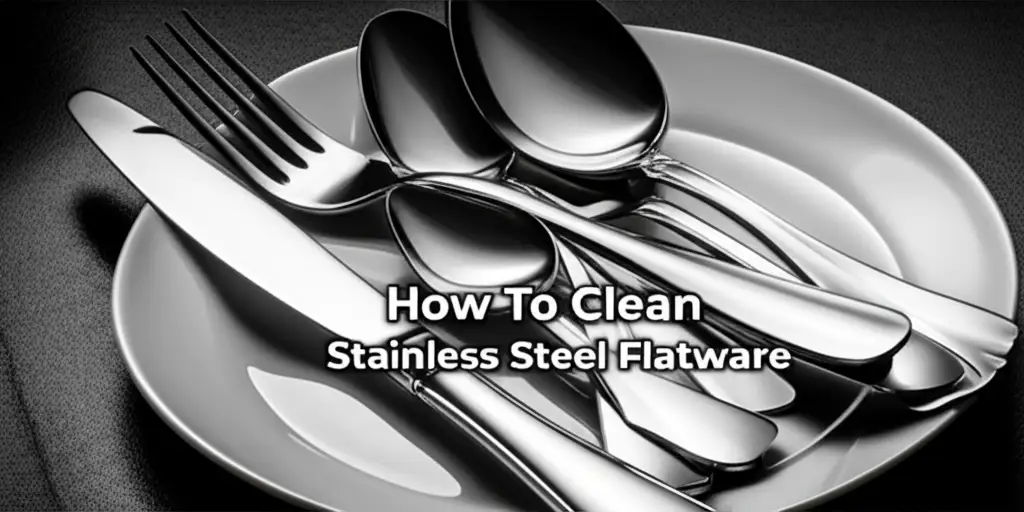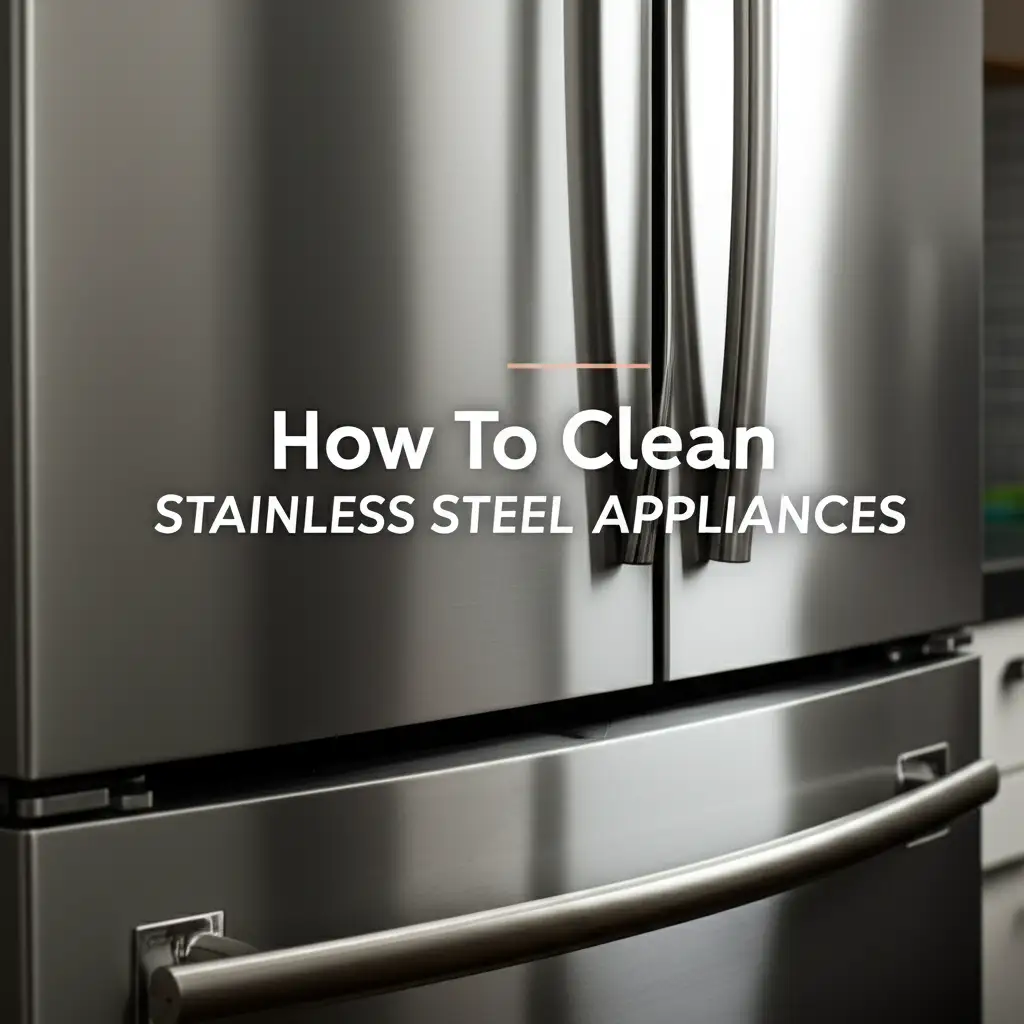· Home Cleaning · 16 min read
How To Clean Stainless Steel Flatware

How to Clean Stainless Steel Flatware Effectively
Do you ever notice your stainless steel flatware losing its sparkle? Over time, even the most durable utensils can develop water spots, rust marks, or a dull finish. Keeping your forks, spoons, and knives looking new requires specific cleaning methods. Learning how to clean stainless steel flatware properly extends its life and keeps your dining table looking its best. This guide offers simple, effective steps to maintain and restore the shine of your everyday cutlery. We will cover daily cleaning, stain removal, rust treatment, and polishing techniques.
Takeaway
- Hand wash stainless steel flatware for best results, especially after acidic foods.
- Use vinegar and baking soda to remove water spots and mild discoloration.
- Treat rust spots promptly with gentle abrasives or a rust remover.
- Always dry flatware immediately to prevent new spots and maintain shine.
How do you clean stainless steel flatware?
To clean stainless steel flatware, wash it promptly after use with dish soap and warm water, then dry immediately to prevent water spots. For tougher stains or dullness, use a paste of baking soda and water, or a vinegar solution, scrubbing gently before rinsing and drying.
Understanding Stainless Steel Flatware
Stainless steel is a popular material for flatware. It resists rust and corrosion due to its chromium content. However, it is not entirely stain-proof. Hard water, certain foods, and even improper drying can cause issues. Understanding these factors helps you keep your flatware in top condition.
Different grades of stainless steel exist, such as 18/10, 18/8, and 18/0. The numbers refer to chromium and nickel content. Higher nickel content (like in 18/10) generally means more shine and better corrosion resistance. Knowing your flatware type helps tailor your cleaning approach. Even high-quality stainless steel can develop problems if not cared for correctly. This material is designed for durability but still benefits from careful handling.
Common issues include dullness from mineral deposits, water spots from improper drying, and even slight rust marks. These problems usually do not mean your flatware is ruined. They often respond well to simple cleaning techniques. Regular care prevents these issues from becoming permanent. Proper maintenance keeps your stainless steel flatware looking good for many years.
Everyday Cleaning for Stainless Steel Flatware
Daily cleaning is crucial for maintaining your flatware’s appearance. Prompt washing prevents food particles from drying and staining. You have two main options: hand washing or using a dishwasher. Both methods can be effective if done correctly.
Hand Washing Your Flatware
Hand washing is often the gentlest method for stainless steel flatware. It helps prevent scratches and water spots. I find this method gives me the most control over the cleaning process.
- Rinse Immediately: Rinse off food residue right after use. This stops food acids from etching the surface.
- Use Mild Soap: Wash with warm water and a gentle dish soap. Avoid harsh chemicals or abrasive scrubbers. A soft sponge or cloth works best.
- Dry Thoroughly: This step is the most important. Dry each piece immediately with a clean, soft towel. Air drying often leads to water spots, especially with hard water.
Using a Dishwasher for Flatware
Dishwashers offer convenience, but they can sometimes cause problems for stainless steel. High heat and certain detergents can contribute to dullness or spots.
- Load Correctly: Place forks and spoons handle-down in the basket. Knives should go handle-up for safety. Avoid overcrowding the basket.
- Use Recommended Detergent: Choose a dishwasher detergent safe for stainless steel. Avoid those with harsh chlorine bleach.
- Add Rinse Aid: A rinse aid helps water sheet off, reducing water spots. This is especially helpful if you have hard water.
- Remove Promptly: Remove flatware from the dishwasher as soon as the cycle finishes. Dry any remaining water spots with a towel. Do not let it sit in a damp dishwasher.
- Pre-Soak Heavily Soiled Items: For items with stubborn food, a quick pre-soak in warm water can prevent problems in the dishwasher. This also helps with removing various food stains effectively. For general tips on how to remove stains, you might find this article helpful: How To Clean Stains on Stainless Steel.
Tackling Common Stains on Stainless Steel Flatware
Even with regular cleaning, stainless steel flatware can develop stubborn stains. Water spots, discoloration from minerals, and food residue are common issues. Knowing the right approach helps restore your flatware’s shine. Different stains require different cleaning agents.
Removing Water Spots and Mineral Deposits
Water spots appear as cloudy marks. They result from minerals in hard water drying on the surface. These are common and easy to fix.
- Vinegar Solution: Mix equal parts white vinegar and warm water. Soak the flatware in this solution for 5-10 minutes. The acid in vinegar dissolves mineral deposits. You can also spray vinegar directly on the spots.
- Wipe and Polish: Wipe the flatware clean with a soft cloth. Then, buff it dry to a shine. For more general cleaning with vinegar, consider these tips: How To Clean Stainless Steel Appliances with Vinegar.
- Lemon Juice Alternative: Fresh lemon juice works similarly to vinegar. Squeeze lemon juice onto a cloth and wipe the spots. Rinse well and dry immediately.
Dealing with Food Stains and Discoloration
Food acids or strong pigments can cause discoloration. These might include tea stains, coffee stains, or tomato residue. Act quickly to prevent permanent marks.
- Baking Soda Paste: Mix baking soda with a small amount of water to form a paste. Apply the paste to the stained area. Let it sit for 10-15 minutes.
- Gentle Scrub: Use a soft cloth or sponge to gently scrub the stain. Baking soda is a mild abrasive that lifts grime. Rinse the flatware thoroughly under warm water.
- For Tea Stains: If you specifically have tea stains, a dedicated approach is best. Learn more about effective methods here: How To Clean Tea Stains From Stainless Steel.
- Avoid Steel Wool: Never use steel wool or harsh abrasive pads. They can scratch the stainless steel surface. Scratches make the flatware more prone to future staining and dullness. Stick to non-abrasive materials for best results.
Removing Rust and Tarnish from Stainless Steel Flatware
Rust on stainless steel flatware is a common but fixable issue. It often appears as small brown spots. This does not mean your flatware is ruined. Tarnish refers to a dull, darkened appearance. Both issues require specific attention to restore the flatware’s look.
Treating Rust Spots
Rust on stainless steel flatware often comes from contact with other metals. For instance, a rusty pan in the dishwasher can transfer rust to your flatware. This is sometimes called “flash rust.”
- Baking Soda and Water: Make a thick paste with baking soda and a little water. Apply the paste directly to the rust spot. Let it sit for several hours or even overnight. The baking soda’s mild abrasive nature helps lift the rust.
- Rub Gently: Use a soft cloth or a non-scratch scrub pad to gently rub the rust spot. Rinse the flatware well with water. Dry it immediately and thoroughly.
- Bar Keepers Friend: This product is excellent for stainless steel. It contains oxalic acid which dissolves rust. Apply a small amount to a damp cloth. Gently rub the rusty area. Rinse thoroughly and dry completely.
- Lemon Juice and Salt: Sprinkle a little salt on the rust spot. Squeeze fresh lemon juice over the salt. Let it sit for a few minutes. The acid in the lemon juice and the abrasive salt help break down the rust. Scrub gently, then rinse and dry.
- Prevent Rust Transfer: To prevent rust from forming, avoid letting stainless steel flatware touch other metal items in the dishwasher. Learn more about removing rust from various stainless steel items here: How To Clean Rust Off Stainless Steel.
Removing Tarnish and Dullness
Over time, stainless steel can lose its bright shine and appear dull. This is tarnish, often due to mineral deposits or residue buildup.
- White Vinegar Soak: For overall dullness, soak your flatware in undiluted white vinegar for 30 minutes. The vinegar helps dissolve built-up residue.
- Polish with Olive Oil: After cleaning and drying, put a small amount of olive oil on a soft cloth. Rub the oil into the flatware, buffing it to a high shine. This creates a protective barrier.
- Stainless Steel Cleaner/Polish: Commercial stainless steel cleaners are available. Choose one specifically designed for flatware or utensils. These products restore shine and offer some protection. Remember to use products designed for food contact surfaces. These are generally safe for your kitchen items, including your flatware and other kitchen utensils. For broader tips, consider these methods for cleaning all your stainless steel utensils: How To Clean Stainless Steel Utensils.
Polishing and Maintaining Stainless Steel Flatware’s Shine
Keeping your stainless steel flatware shiny and new-looking is simpler than you might think. Regular polishing not only enhances appearance but also adds a layer of protection. This helps prevent future spots and marks. I always take a few extra minutes to do this after cleaning.
Polishing for Brilliant Shine
After cleaning, polishing is the final step to achieve that mirror-like finish. It removes any lingering film and brings out the steel’s natural luster.
- Microfiber Cloth: The best tool for polishing is a clean, dry microfiber cloth. Its fine fibers buff surfaces without scratching.
- Gentle Buffing: Rub each piece of flatware firmly but gently. Use circular motions or follow the grain of the steel. You will see the shine emerge quickly.
- Food-Grade Mineral Oil: For an extra boost of shine and protection, apply a tiny drop of food-grade mineral oil to your microfiber cloth. Buff it into the flatware. This helps repel water and fingerprints. It also makes the flatware feel smoother. Be sure to use only a very small amount and buff thoroughly to avoid a greasy feel.
- Commercial Stainless Steel Polish: Many stores sell polishes specifically for stainless steel. Choose one that is food-safe. Always follow the product’s directions for application and removal. These polishes often contain agents that protect against future smudges.
Long-Term Maintenance Tips
Maintaining your flatware’s shine involves consistent habits. Simple practices can make a big difference over time. These habits extend the life and beauty of your flatware.
- Avoid Abrasives: Never use steel wool, abrasive scouring pads, or harsh powdered cleaners. They can scratch the flatware’s surface. These scratches create microscopic grooves where food and minerals can hide. This makes the flatware harder to clean and more prone to dullness.
- Store Properly: Store flatware in a dry, well-ventilated drawer or caddy. Avoid storing it with other metals that might rust. Rust from one item can transfer to stainless steel.
- Separate Silverware: If you have silver or silver-plated flatware, store it separately. Chemical reactions between different metals can cause discoloration on stainless steel. While this article focuses on stainless steel, understanding how to clean silver-plated items is also important for comprehensive flatware care: How To Clean Silver Plated Flatware.
- Regular Deep Clean: Even with daily care, schedule a deep clean every few months. This involves soaking in vinegar or a mild cleaner to address any hidden buildup. This keeps your flatware sparkling and ready for any occasion.
Deep Cleaning and Restoring Older Stainless Steel Flatware
Sometimes, your stainless steel flatware needs more than just a quick wash. Older pieces or those that have been neglected can accumulate stubborn grime, deep-seated stains, or a thick layer of dullness. A deep cleaning process can revitalize these items. It helps restore their original luster and makes them look new again.
Restoring Heavily Stained or Dull Flatware
Heavily stained flatware often has mineral buildup, dried food residues, or extensive water spots. A more intensive approach can remove these tough marks.
- Boiling Method: This method is effective for loosening stubborn buildup.
- Prepare a Pot: Fill a large pot with water. Add a few tablespoons of white vinegar and a tablespoon of baking soda.
- Boil Flatware: Place your dull or stained flatware in the pot. Bring the water to a boil. Let it simmer for 10-15 minutes. The hot water, vinegar, and baking soda work together to break down grime.
- Cool and Clean: Carefully remove the pot from the heat. Let the water cool down enough to handle the flatware safely. Once cool, remove each piece. Scrub any remaining residue with a soft brush or sponge.
- Rinse and Dry: Rinse thoroughly under warm water. Dry each piece immediately with a soft, clean towel.
- Lemon and Salt Scrub (for specific stains): For very specific, localized stains, a strong natural abrasive might help. Cut a lemon in half. Dip the cut side in salt. Use this to scrub the affected areas. Rinse completely. This is a powerful, natural solution.
Addressing Scratches and Minor Damage
While stainless steel is durable, it can get minor scratches over time. These scratches can make flatware look worn. They can also trap dirt.
- Stainless Steel Scratch Removal Kits: You can find specialized kits designed to minimize the appearance of scratches on stainless steel. These often include abrasive pads and polishing compounds. Always follow the manufacturer’s instructions carefully. These kits work by gently abrading the surrounding surface to blend in the scratch.
- Toothpaste Method (for very fine scratches): For extremely minor surface scratches, a non-gel toothpaste can act as a mild abrasive. Apply a small amount to a soft cloth. Gently rub the scratch in the direction of the grain. Rinse thoroughly and polish. This method is for very light imperfections only.
- Professional Polishing: For deep scratches or overall restoration of a large collection, consider professional polishing services. They have specialized equipment to buff and restore the metal without damaging it. This option is usually for very valuable or heirloom pieces. This process is similar to how a professional might restore a large stainless steel surface. For context on cleaning larger stainless steel items, consider how to manage How To Clean Stainless Steel Appliances.
Preventive Care for Long-Lasting Stainless Steel Flatware
Preventing problems is always easier than fixing them. A few simple habits can keep your stainless steel flatware looking pristine for years. These practices protect the metal from damage and reduce the need for intensive cleaning. I have found these tips make a big difference in my own kitchen.
Best Practices to Avoid Damage
Careful handling and storage are key to preventing scratches, rust, and dullness. Think of it as protecting an investment.
- Avoid Corrosive Foods: Certain foods are highly acidic or contain strong salts. Examples include ketchup, mustard, vinegar, and citrus juices. These can etch the stainless steel if left on for too long. Rinse your flatware immediately after using it with these foods. This simple step stops potential damage before it starts.
- Separate from Silverware: Never allow stainless steel and silver (or silver-plated) flatware to touch in the sink or dishwasher. This can cause a chemical reaction. The reaction can lead to dark spots or pitting on both types of metal. Store them in separate compartments in your drawer.
- Check Dishwasher Detergent: Some dishwasher detergents contain strong chemicals like chlorine bleach. These can harm stainless steel over time. Choose a detergent specifically labeled as safe for stainless steel. Look for formulas that are bleach-free.
- Handle Knives Carefully: Knives are often made with different grades of stainless steel in the blade versus the handle. The blade might be more prone to rusting. Wash knives promptly and dry them immediately, especially the blade portion. This prevents water from sitting on the edge and causing corrosion.
Storage and Handling Tips
Proper storage keeps your flatware safe from scratches and environmental factors. It also helps maintain its polished look.
- Use a Flatware Organizer: A drawer organizer with separate compartments for forks, spoons, and knives prevents them from rubbing against each other. This reduces scratches and maintains the finish.
- Store in Dry Conditions: Humidity can contribute to water spots and even rust over time. Ensure your flatware drawer is dry. Avoid storing flatware in damp areas, such as directly under a sink that might leak.
- Air Circulation: If possible, store flatware in an area with some air circulation. This helps prevent moisture from accumulating. It keeps your flatware dry and ready for use.
- Occasional Hand Buffing: Even if you dishwasher your flatware, occasionally hand-dry and buff it with a soft cloth. This removes any lingering film and restores shine. It is a quick way to keep your flatware looking its best. This kind of attention also applies to other stainless steel items in your kitchen. For instance, knowing how to clean stainless steel pans can extend their life and appearance.
FAQ Section
Can I put all stainless steel flatware in the dishwasher?
Most stainless steel flatware is dishwasher safe. However, hand washing is often gentler and helps prevent water spots or dullness, especially if you have hard water. Always remove flatware promptly after the cycle ends and dry it to prevent spots.
How do I remove black spots from stainless steel flatware?
Black spots are often a result of oxidation or hard water minerals. You can typically remove them with a paste made of baking soda and water. Apply the paste, let it sit, then gently scrub with a soft cloth. Rinse thoroughly and dry completely.
What causes rust spots on stainless steel flatware?
Rust spots, often called “flash rust,” occur when stainless steel comes into contact with rusty items, like cast iron pans or cheap dish racks, in a damp environment. High iron content in water or certain acidic foods can also contribute. Remove promptly to prevent spread.
Is vinegar safe for cleaning stainless steel flatware?
Yes, white vinegar is very safe and effective for cleaning stainless steel flatware. Its mild acidity helps dissolve water spots, mineral deposits, and light discoloration. Use it diluted with water for general cleaning, or undiluted for tougher stains, followed by a thorough rinse.
How often should I deep clean my stainless steel flatware?
Deep cleaning stainless steel flatware is not a daily task. I recommend a deep clean every few months, or whenever you notice significant dullness, stubborn stains, or minor rust spots. Regular daily cleaning helps reduce the frequency of deep cleaning.
Can stainless steel flatware be polished with olive oil?
Yes, you can use a tiny amount of olive oil to polish stainless steel flatware. After cleaning and drying, apply a very small drop to a clean, soft cloth. Buff the flatware to a shine. This helps enhance luster and repel fingerprints, but ensure you buff it off completely to avoid a greasy residue.
Conclusion
Keeping your stainless steel flatware sparkling does not need to be a chore. By understanding the material and following a few simple steps, you can maintain its beauty for years. From daily washing to tackling tough stains and preventing future damage, each tip contributes to long-lasting shine. Remember, immediate drying after washing is the most impactful step for preventing water spots and maintaining brilliance.
My hope is that these guidelines empower you to restore and preserve your cutlery. Regular care, paired with the right techniques, keeps your dining experience enjoyable. Make cleaning stainless steel flatware a simple part of your kitchen routine. Your gleaming utensils will thank you. Start today, and enjoy the lasting sparkle on your table.
- stainless steel flatware
- clean utensils
- flatware care
- remove rust
- kitchen cleaning tips




